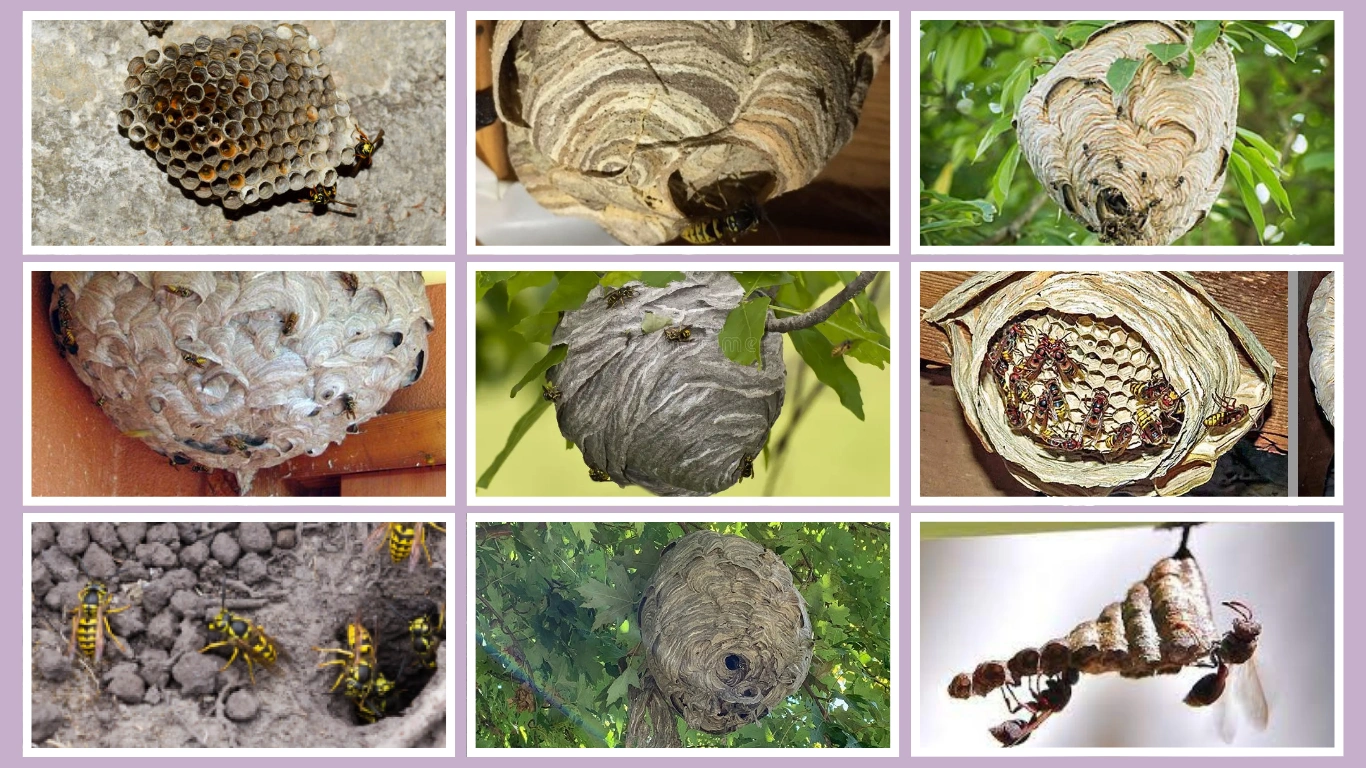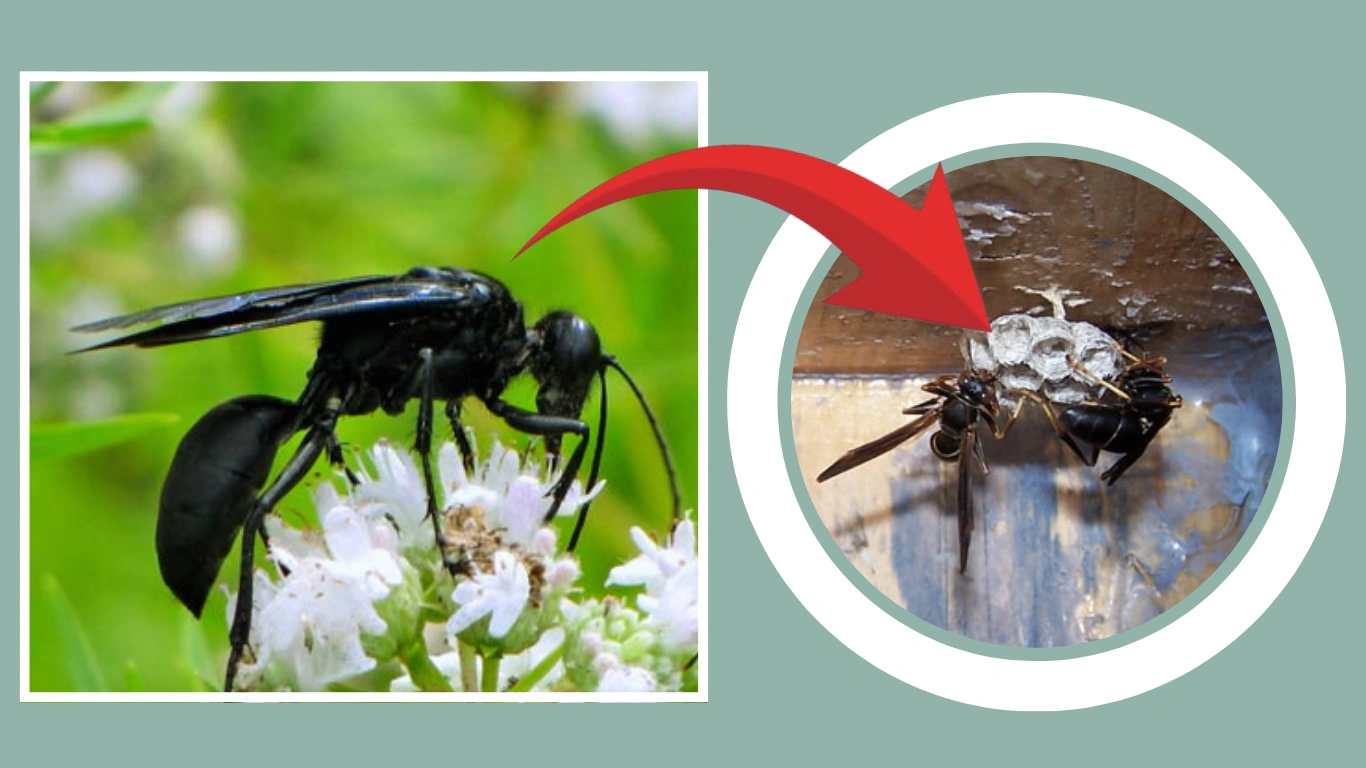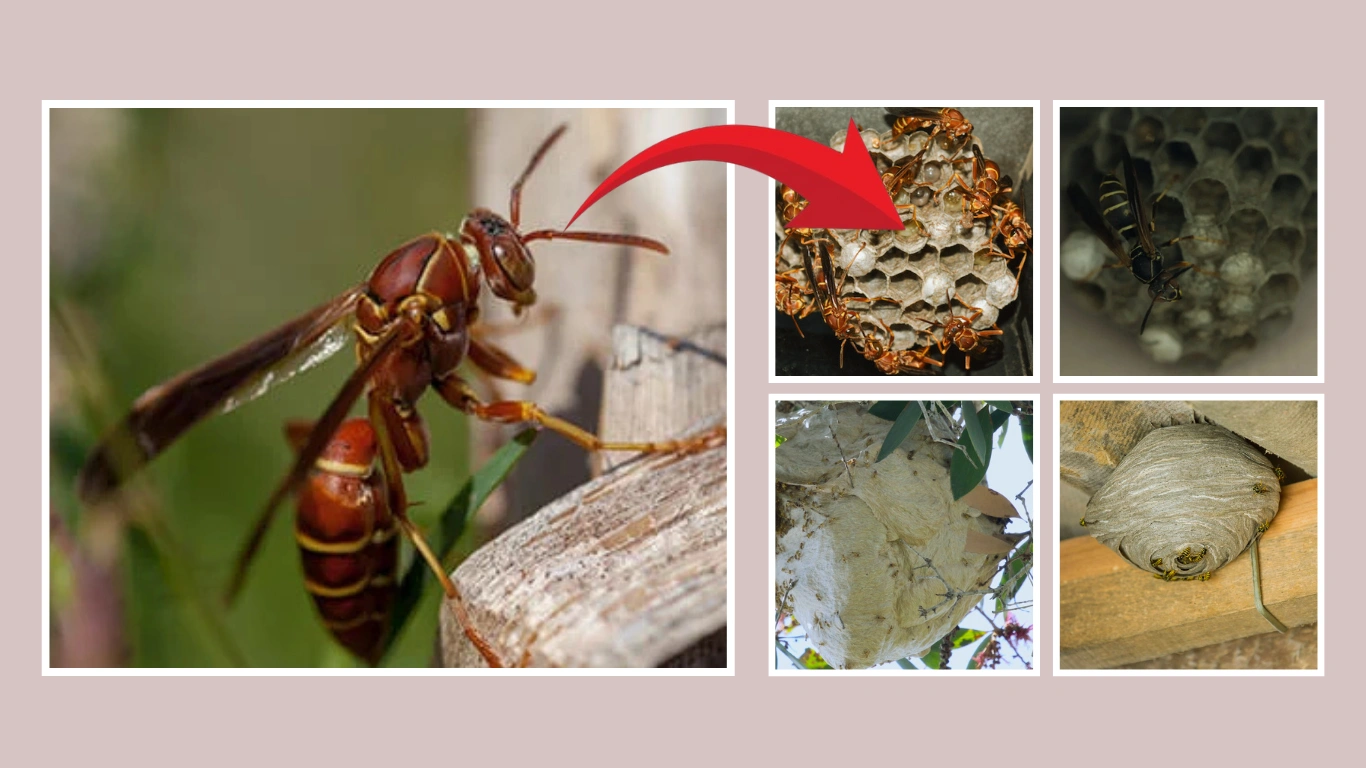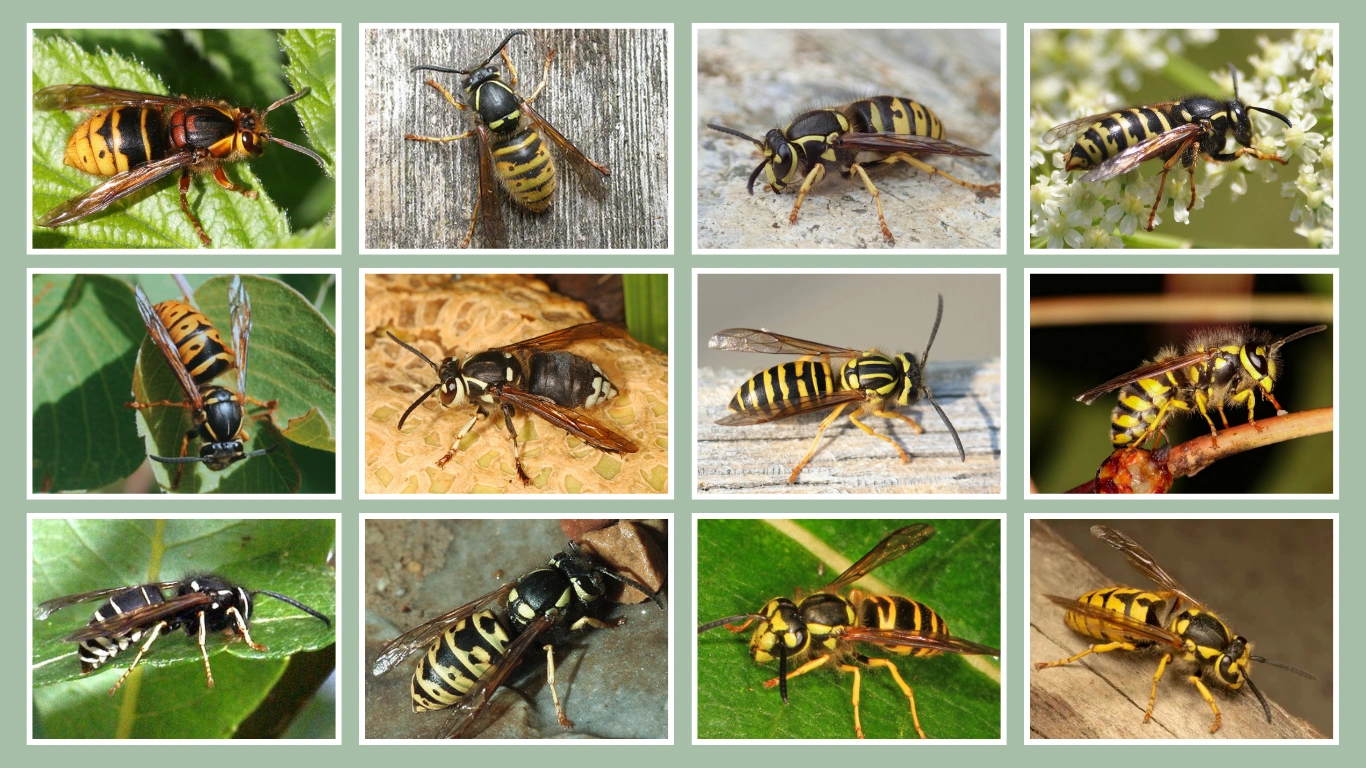Did you know that many wasps build intricate paper nests using chewed wood and saliva? From small umbrella-shaped structures to massive aerial nests, these paper architects vary widely in style and size. In this guide, you’ll discover 10 wasp species known for their paper nests—along with unique nest features, locations, and seasonal behaviors that set each species apart.
1. Polistes dominula – Nest Characteristics
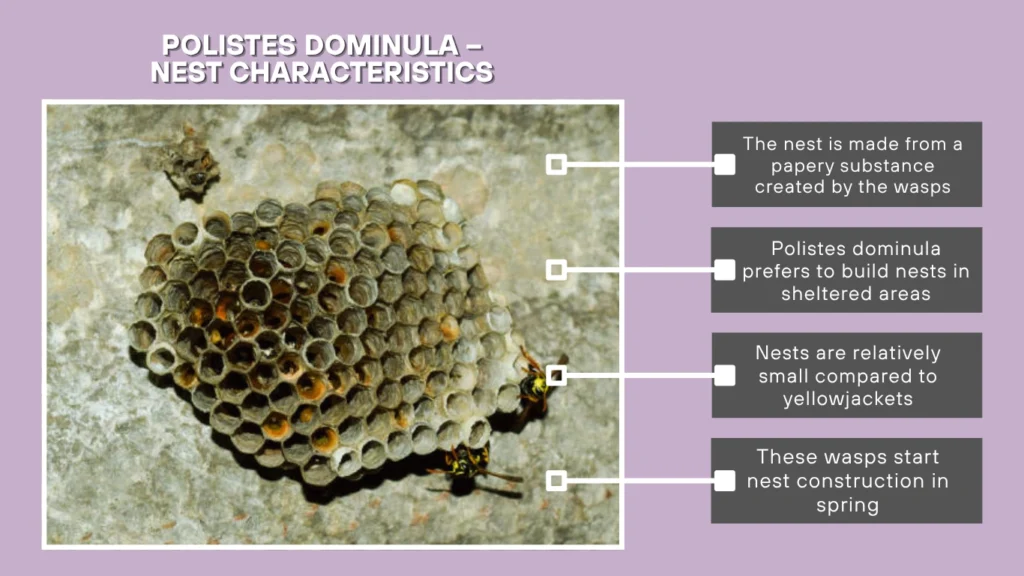
Polistes dominula, commonly known as the European paper wasp, builds small, open, umbrella-shaped nests. The nest consists of a single layer of hexagonal cells, usually left uncovered (no outer envelope), which makes the larvae and pupae visible. These cells are used to rear the brood and store food.
Nest Material
The nest is made from a papery substance created by the wasps. They chew weathered wood or plant fibers, mix it with saliva, and form a pulp that hardens into a papery texture. This gives the nest a grayish, fragile appearance.
Nest Location
Polistes dominula prefers to build nests in sheltered areas, often under eaves, roof overhangs, inside sheds, attics, or wall crevices. Nests are usually suspended by a thin stalk, which deters ants and provides stability.
Colony Size
Nests are relatively small compared to yellowjackets or hornets, typically housing a few dozen wasps. However, they may expand slightly over the season, depending on conditions and queen productivity.
Seasonal Behavior
These wasps start nest construction in spring. As temperatures drop in autumn, the colony declines and the nest is abandoned. They do not reuse nests the following year.
2. Vespula vulgaris – Nest Characteristics
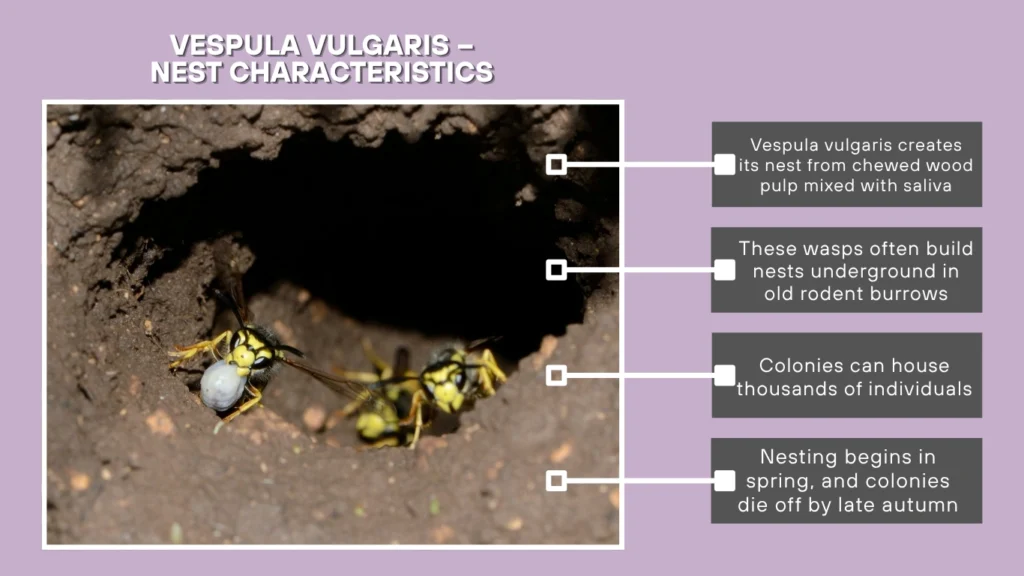
The common wasp (Vespula vulgaris) constructs large, enclosed nests with multiple layers of comb. These nests can grow significantly in size, accommodating thousands of wasps. The outer envelope covers the entire nest, giving it a rounded or oval shape.
Nest Material
Vespula vulgaris creates its nest from chewed wood pulp mixed with saliva, forming a papery material. The result is a sturdy yet lightweight structure that appears gray or brown with a slightly rough texture.
Nest Location
These wasps often build nests underground in old rodent burrows, tree hollows, or wall cavities. They also occupy attics and sheds. Nest entrances are usually small and hard to detect, especially when underground.
Colony Size
Colonies can house thousands of individuals. Nest growth continues through summer and peaks in late summer or early autumn.
Seasonal Behavior
Nesting begins in spring, and colonies die off by late autumn. New queens leave the nest to overwinter and begin new colonies the next year.
3. Dolichovespula maculata – Nest Characteristics
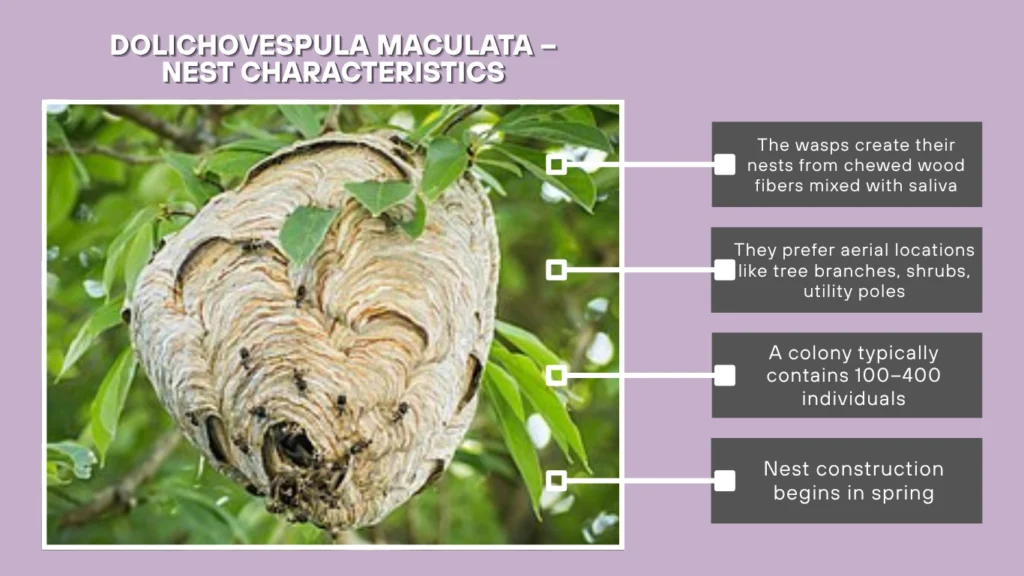
Commonly known as the bald-faced hornet, Dolichovespula maculata builds large, football-shaped paper nests that hang from trees, bushes, or buildings. These nests are fully enclosed with a smooth, layered outer shell.
Nest Material
The wasps create their nests from chewed wood fibers mixed with saliva. The resulting paper-like material gives the nest a grayish-white appearance with visible swirls and layers.
Nest Location
They prefer aerial locations like tree branches, shrubs, utility poles, or building corners. Nests are highly visible due to their size and placement.
Colony Size
A colony typically contains 100–400 individuals. The size and complexity of the nest increase throughout the season.
Seasonal Behavior
Nest construction begins in spring. Colonies reach peak size in late summer and die out in fall. Nests are not reused the next year.
4. Vespula germanica – Nest Characteristics
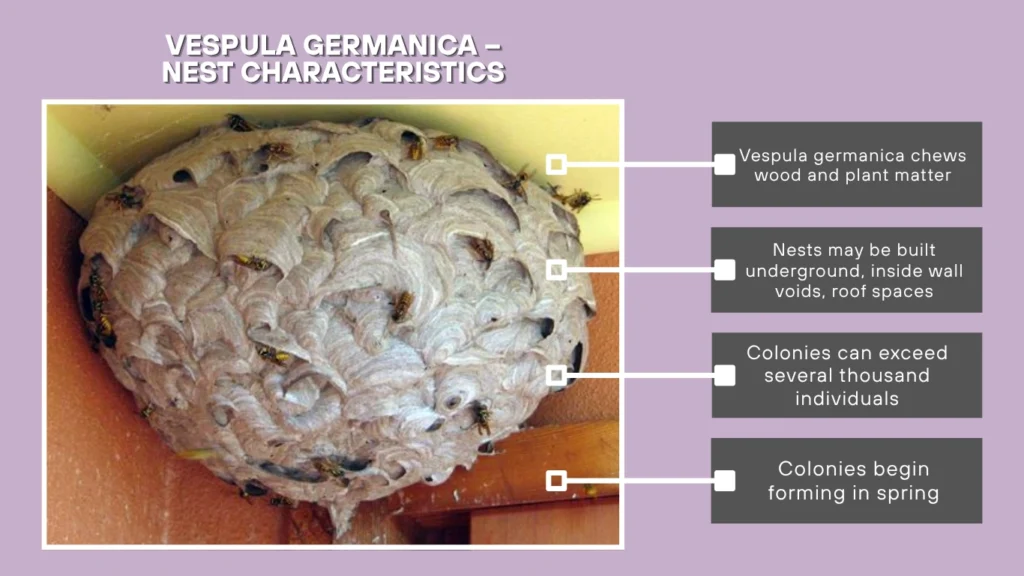
The German wasp builds large, enclosed nests composed of layered combs protected by a papery envelope. The structure is robust and well-ventilated, with a central entrance and multiple tiers for raising larvae.
Nest Material
Vespula germanica chews wood and plant matter, mixing it with saliva to form a durable gray or brown paper-like substance. The layered texture gives the nest a swirled, fibrous look.
Nest Location
This species is highly adaptable. Nests may be built underground, inside wall voids, roof spaces, tree stumps, or even above ground in bushes and sheds. Urban environments often attract them due to easy shelter access.
Colony Size
Colonies can exceed several thousand individuals, making their nests among the largest of paper-nest builders in temperate zones.
Seasonal Behavior
Colonies begin forming in spring. By late summer, the nests are at full capacity. Wasps die off in fall, with only new queens surviving winter to restart the cycle.
5. Dolichovespula arenaria – Nest Characteristics
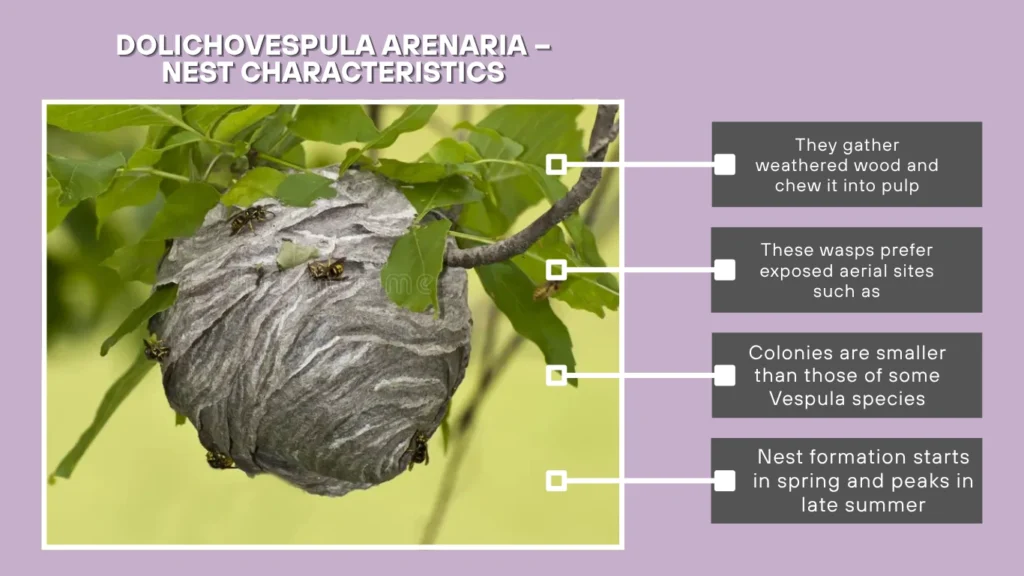
Known as the aerial yellowjacket, Dolichovespula arenaria constructs oval or spherical paper nests that hang above ground. The nest has an outer covering and multiple inner combs arranged horizontally.
Nest Material
They gather weathered wood and chew it into pulp, forming a paper-like material. The resulting nest has a light gray appearance with visible fibrous layers.
Nest Location
These wasps prefer exposed aerial sites such as tree branches, shrubs, eaves, and sometimes even utility poles or attic rafters. The nests hang securely by a single stalk or base.
Colony Size
Colonies are smaller than those of some Vespula species, typically consisting of 100 to 700 individuals.
Seasonal Behavior
Nest formation starts in spring and peaks in late summer. By fall, the colony declines, and the nest is abandoned. It is not reused in future seasons.
6. Vespa crabro – Nest Characteristics
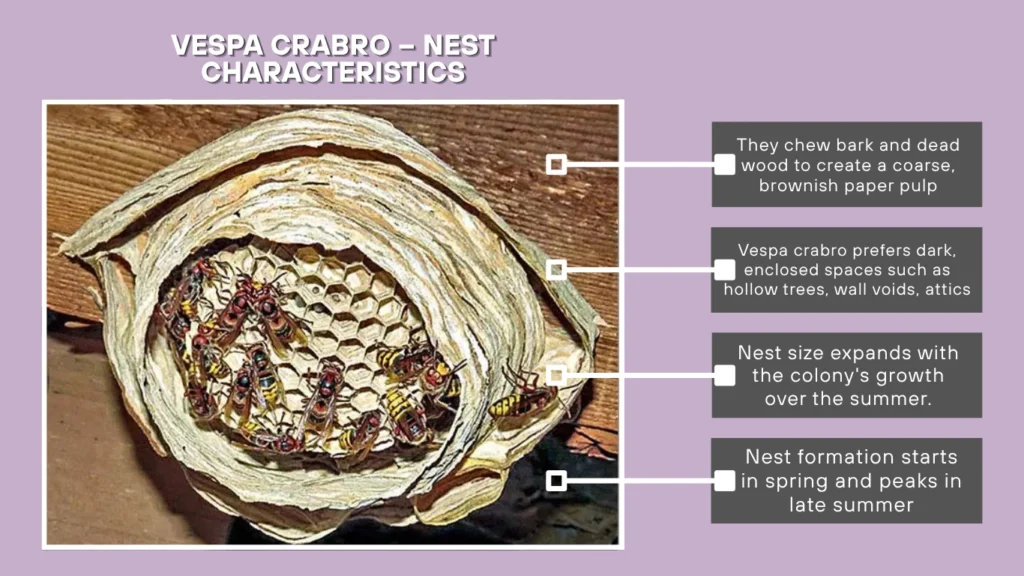
The European hornet (Vespa crabro) builds large, enclosed nests with layered horizontal combs protected by a thick outer envelope. The nest is oval or teardrop-shaped and features a single entrance at the bottom.
Nest Material
They chew bark and dead wood to create a coarse, brownish paper pulp. Their nests are usually darker and rougher in texture compared to other paper wasps.
Nest Location
Vespa crabro prefers dark, enclosed spaces such as hollow trees, wall voids, attics, or barns. Occasionally, they also build nests in open but shaded spots, like under porches.
Colony Size
A typical colony has a few hundred to over a thousand members. Nest size expands with the colony’s growth over the summer.
Seasonal Behavior
Colonies begin in spring and reach peak population in late summer. The nest dies off by fall, with only mated queens overwintering to start new colonies the following year.
7. Vespula pensylvanica – Nest Characteristics
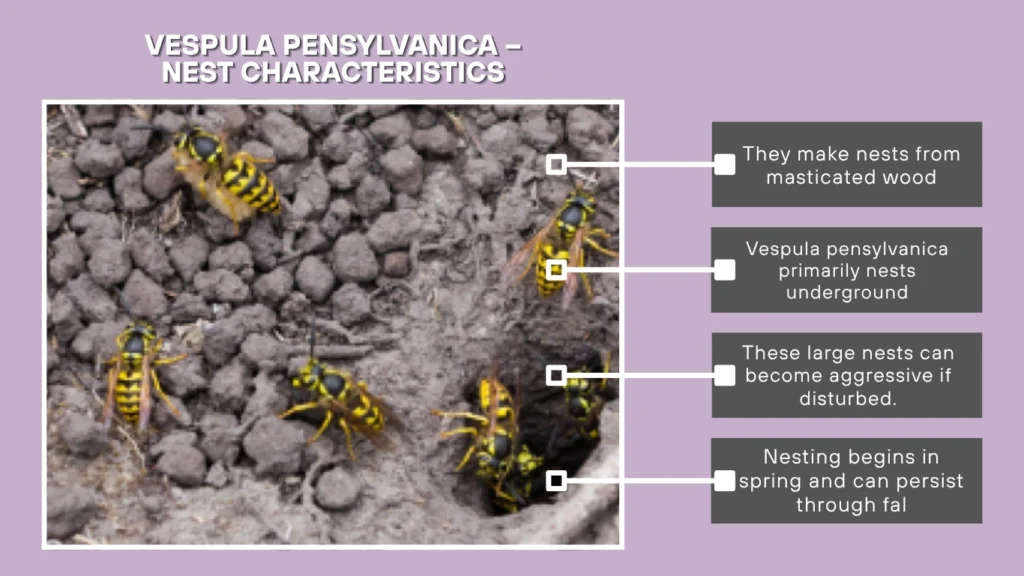
The western yellowjacket creates fully enclosed nests with multiple comb layers. The paper shell encases the brood area and maintains temperature and humidity levels for developing larvae.
Nest Material
They make nests from masticated wood and plant fibers mixed with saliva, resulting in a grayish, papery appearance that may darken with age and exposure.
Nest Location
Vespula pensylvanica primarily nests underground, especially in abandoned rodent burrows. However, they also occupy wall voids, crawl spaces, and sheds when soil sites are unavailable.
Colony Size
Colonies can exceed 5,000 individuals in favorable climates, especially in western North America. These large nests can become aggressive if disturbed.
Seasonal Behavior
Nesting begins in spring and can persist through fall, especially in warm regions. In some temperate climates, colonies may even survive through winter, making them perennial.
8. Dolichovespula norvegica – Nest Characteristics
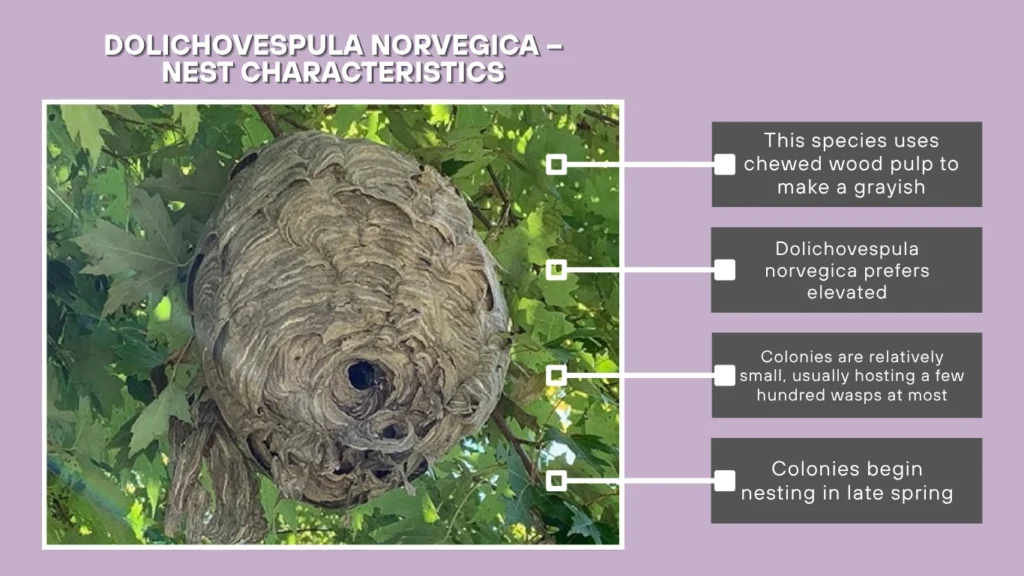
The Norwegian wasp builds small to medium-sized paper nests that are enclosed with a layered outer envelope. Inside, horizontal combs hold developing larvae. The nests are oval or round and hang from a narrow stalk.
Nest Material
This species uses chewed wood pulp to make a grayish, paper-like substance. The texture of the nest is slightly fibrous and smooth, similar to other aerial wasps.
Nest Location
Dolichovespula norvegica prefers elevated, open locations such as tree branches, shrubs, fences, or under building eaves. Nests are often exposed and visible, typically suspended above the ground.
Colony Size
Colonies are relatively small, usually hosting a few hundred wasps at most. This species tends to remain less aggressive and more solitary in behavior.
Seasonal Behavior
Colonies begin nesting in late spring. The nest grows through the summer and is abandoned by early autumn. It is not reused in subsequent years.
9. Ropalidia marginata – Nest Characteristics
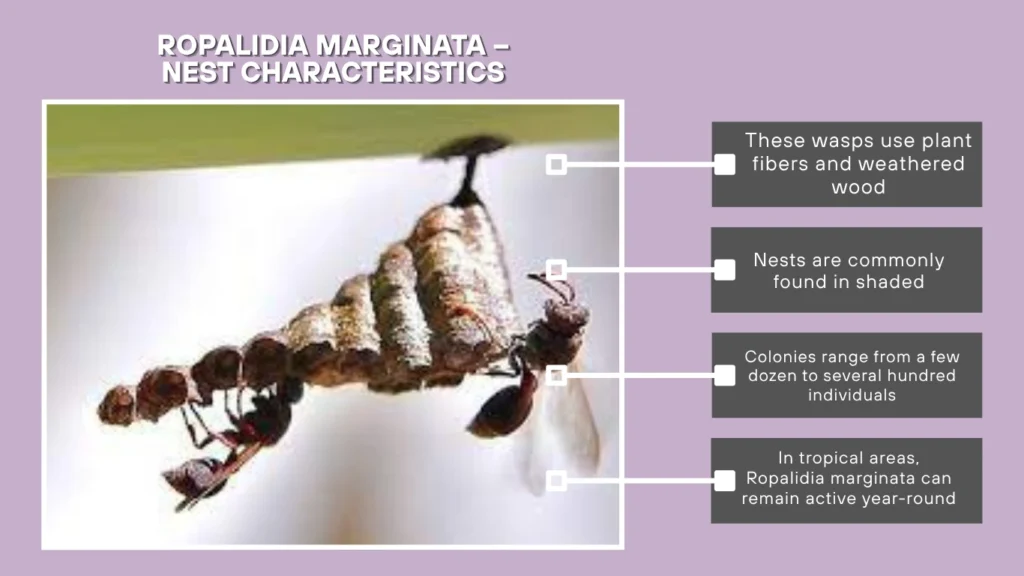
Ropalidia marginata, a tropical paper wasp, constructs open-comb nests with no outer envelope. The combs are arranged in rows and hang by a central stalk, exposing all the brood cells.
Nest Material
These wasps use plant fibers and weathered wood to create a fine-textured paper pulp. The finished nests appear thin and fragile but are functionally strong in tropical climates.
Nest Location
Nests are commonly found in shaded and sheltered outdoor spaces—under roof overhangs, branches, balconies, or within sheds. Being tropical, they often nest in areas with high humidity and warmth.
Colony Size
Colonies range from a few dozen to several hundred individuals, depending on nest age and environmental conditions.
Seasonal Behavior
In tropical areas, Ropalidia marginata can remain active year-round. Their nests are not seasonal and may be reused or maintained continuously.
10. Vespa velutina – Nest Characteristics
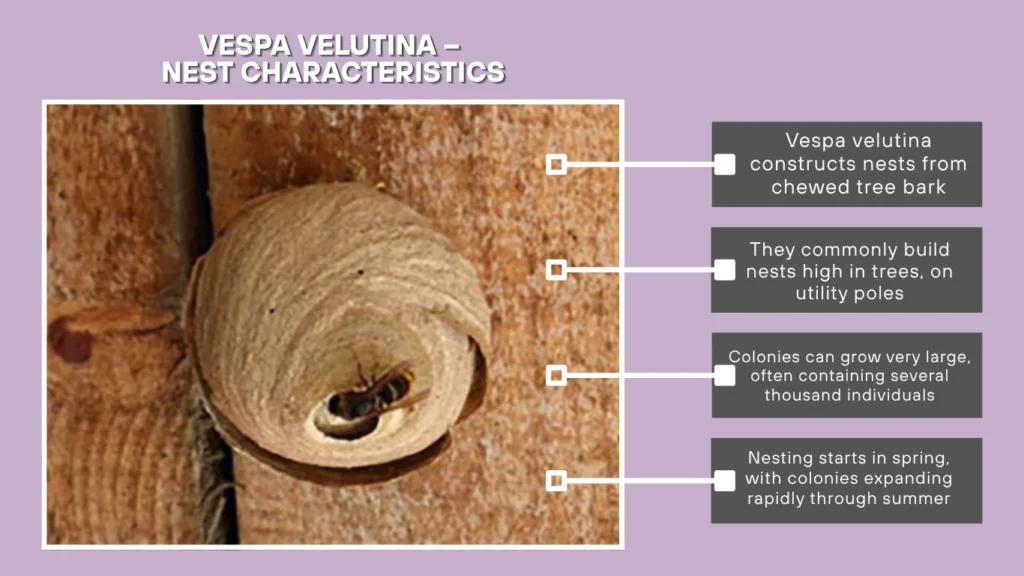
The Asian hornet (Vespa velutina) builds large, round to oval-shaped enclosed nests with multiple comb layers inside. The nests have a papery outer shell with a single entrance, typically located near the side rather than the bottom.
Nest Material
Vespa velutina constructs nests from chewed tree bark and plant fibers mixed with saliva, producing a layered, brownish-gray paper. The outer shell often displays distinct swirls and color bands.
Nest Location
They commonly build nests high in trees, on utility poles, or under roof overhangs. Occasionally, nests are found in sheds, attics, or wall cavities. Some colonies also begin nesting in low bushes or buildings before relocating higher as they grow.
Colony Size
Colonies can grow very large, often containing several thousand individuals. Invasive populations in Europe are known to create especially large and aggressive colonies.
Seasonal Behavior
Nesting starts in spring, with colonies expanding rapidly through summer. The nest reaches its peak in late autumn. Like other temperate wasps, only mated queens survive winter to form new nests the following spring.
